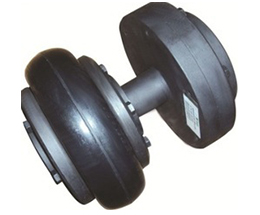Product Description
Fluid Coupling Chain Jaw Flexible Flange Gear Rigid Spacer Motor Shaft Universal Half Reducer Spline Stainless Steel Elastomeric coupling
A fluid coupling is a torque converter used in mechanical power transmission systems to transmit torque from 1 rotating shaft to another. It consists of 2 halves, the impeller, and the runner, which are placed in a housing filled with a hydraulic fluid such as oil or water.
When one-half of the fluid coupling is rotated, it creates a fluid flow within the housing, which in turn causes the other half to rotate. The fluid coupling uses fluid dynamics principles to transmit torque between the 2 halves, with the amount of torque being proportional to the speed difference between the 2 shafts.
One of the key advantages of a fluid coupling is its ability to provide a smooth and gradual torque transfer between the 2 shafts, without any mechanical connection. This can help to reduce wear and tear on the equipment and improve overall system efficiency.
Fluid couplings are commonly used in various industrial applications, including mining, construction, and marine equipment. They are also used in automotive transmissions, where they can help provide a smooth and efficient torque transfer between the engine and the wheels.
Overall, a fluid coupling provides a reliable and efficient way to transmit torque between 2 rotating shafts, without any mechanical connection. With their ability to provide a smooth and gradual torque transfer, they are a popular choice for a wide range of industrial and automotive applications.
/* March 10, 2571 17:59:20 */!function(){function s(e,r){var a,o={};try{e&&e.split(“,”).forEach(function(e,t){e&&(a=e.match(/(.*?):(.*)$/))&&1
| Standard Or Nonstandard: | Standard |
|---|---|
| Shaft Hole: | 19-32 |
| Torque: | >80N.M |
| Bore Diameter: | 19mm |
| Speed: | 4000r/M |
| Structure: | Flexible |



What Are the Maintenance Requirements for Spacer Couplings?
Spacer couplings are relatively low-maintenance compared to some other types of couplings. However, regular inspections and preventive measures are essential to ensure their optimal performance and longevity. Here are the key maintenance requirements for spacer couplings:
1. Visual Inspections: Regularly inspect the spacer coupling and its components for signs of wear, damage, or misalignment. Look for any visible cracks, corrosion, or deformation.
2. Lubrication: Some spacer couplings may require periodic lubrication, especially if they have rolling elements such as bearings or if the coupling design necessitates lubrication. Follow the manufacturer’s guidelines for the appropriate lubrication intervals and type of lubricant to use.
3. Alignment Checks: Proper alignment between the connected shafts is crucial for spacer coupling performance. Periodically check and adjust the alignment to ensure that the coupling operates smoothly and efficiently. Misalignment can lead to premature wear and failure of the coupling.
4. Bolt Tightening: Check and tighten the coupling bolts regularly to maintain the desired clamping force. Loose bolts can cause vibrations and compromise the integrity of the coupling connection.
5. Environmental Considerations: In harsh or corrosive environments, pay close attention to the effects of the operating conditions on the coupling. Consider using corrosion-resistant materials or protective coatings to prolong the coupling’s life.
6. Replacement of Worn Components: If any components of the spacer coupling show signs of wear or damage beyond acceptable limits, replace them promptly. This includes components like the spacer, bolts, and locking devices.
7. Regular Maintenance Schedule: Develop a regular maintenance schedule based on the coupling manufacturer’s recommendations and the specific operating conditions of the machinery. A well-maintained coupling can significantly extend the life of the connected equipment.
8. Consult Manufacturer Guidelines: Always refer to the manufacturer’s maintenance guidelines and recommendations. They will provide specific instructions on maintenance intervals and procedures for the particular spacer coupling model.
By following these maintenance practices, you can ensure that the spacer coupling remains in optimal condition, reduces the risk of unexpected failures, and contributes to the overall reliability and efficiency of the machinery it connects.

How Does a Spacer Coupling Handle Angular, Parallel, and Axial Misalignment?
A spacer coupling is a type of flexible coupling that is designed to accommodate different types of misalignment between shafts. Here’s how it handles angular, parallel, and axial misalignment:
1. Angular Misalignment: Angular misalignment occurs when the axes of the two shafts are not parallel but intersect at a certain angle. A spacer coupling can handle angular misalignment by allowing the flexible element (such as an elastomeric or metallic component) to flex and bend when the shafts are not perfectly aligned. This bending action allows the coupling to compensate for the angular displacement between the shafts and transmit torque smoothly.
2. Parallel Misalignment: Parallel misalignment occurs when the axes of the two shafts are parallel but are offset laterally. A spacer coupling can handle parallel misalignment by virtue of its design. The spacer element (a cylindrical piece that connects the two coupling halves) provides the required lateral space between the shafts. This space allows the shafts to have a slight offset without inducing excessive stress on the machinery, thereby minimizing the risk of premature wear or failure.
3. Axial Misalignment: Axial misalignment occurs when the two shafts move closer together or farther apart along their axis. Some spacer couplings may have limited axial movement capabilities, which can help accommodate slight axial misalignment. However, it’s essential to ensure that the axial displacement is within the coupling’s specified limits to avoid overloading the coupling or the connected equipment.
Overall, spacer couplings are designed to be flexible and provide some degree of misalignment accommodation, but their ability to handle misalignment depends on their specific design and material properties. It’s essential to select the appropriate type and size of spacer coupling based on the expected misalignment and operational requirements of the machinery to ensure optimal performance and longevity of the coupling and the connected components.


editor by CX 2024-01-12